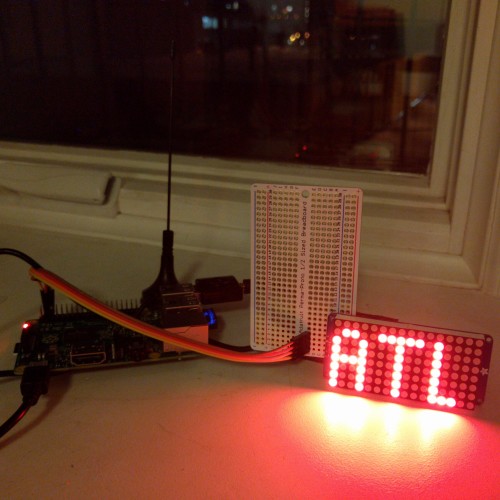When you see or hear a plane flying overhead, many of us wonder where that particular flight is headed to and where it might have come from. Jeremy Merrill is a curious man who happens to live underneath a flight path to LaGuardia Airport in New York City, and devised a brilliant solution to the question (without having to pull up his iPhone all of the time)!
On Jeremy’s blog, he describes the device which displays on his windowsill the departure airport of the plane that happens to be over his apartment at that time. The software he created synthesizes airplane transponder information and generates the origin airport of the plane flying over his apartment. Jeremy describes his invention:
This contraption uses a Raspberry Pi and a Software-Defined Radio antenna, along with some neat software and databases, to display on a 16×8 LED display the departure airport of the airplane that’s flying overhead. The software that runs it, which I’ve dubbed Flyover, is open-source.
For those of you who are technically inclined, Jeremy goes on to describe the process by which this information is generated:
Passenger jets reportedly collect one terabyte of data about themselves per flight. Of that terabyte, most airliners broadcast a tiny portion, unecrypted, over the air, via radio systems called ADS-B and Mode S. Every few seconds, they announce their location, altitude, registration number and – usually – the flight number.
Dump1090 is a program that listens to those broadcasts. Its web interface shows each plane’s precise location and path. I can pick up just about any plane within line of sight of my north-facing window in Prospect Heights. I can “see” planes well into Connecticut or Rockland County, but if the plane shows up even over Prospect Park, I often can’t detect it.
But I don’t want a map on the web. I want a display on my windowsill.
We extract the data on each plane from Dump1090’s JSON feeds, the ones that feed that map. So, we have an always-up-to-date JSON feed of airplanes by their flight number.
But which one to display? New York’s airspace is crowded. Cops, rich dudes and sightseers fly around in their helicopters; we have three major airports nearby. The nearest airplane to my apartment is usually the LaGuardia-bound one, but sometimes a transatlantic flight, or maybe one headed north to Boston, flies over, at a much higher altitude. We have to exclude those. I’ve eyeballed the rough corridor that flights to LaGuardia arrive in and exclude anything outside of there; I also exclude anything higher than 10,000 feet. If it matches those heuristics, the plane is the one I’m curious about.
With that plane’s flight number, we can figure out what route it flies. Virtual Radar Server compiles – and offers, free – a database of routes. It’s not always right, but it’s pretty close, and frequently updated. Suppose the flight number is DAL935 (that is, Delta Air Lines flight 935). We get the route, in the format of “KMCO-KLGA”, since it’s a flight from Orlando, but have to figure out which airport to display.
Sometimes a flight number is only used for, for instance, a once-daily flight from Orlando to LaGuardia. That’s easy – display Orlando’s airport code, MCO (lopping off the K from KMCO; the K just means it’s an airport in the United States). Sometimes, it’s a little harder, because some airlines designate several segments with the same flight number: maybe a flight from Orlando, to LaGuardia, then to Chicago. In that case, if the plane is descending, display Orlando; if it’s ascending, then Chicago.
If that description meant very little to you, don’t worry, you’re not alone. Your takeaway is probably the same as mine: where can I get one of these!
The responses below are not provided or commissioned by the bank advertiser. Responses have not been reviewed, approved or otherwise endorsed by the bank advertiser. It is not the bank advertiser's responsibility to ensure all posts and/or questions are answered.
